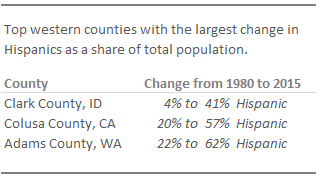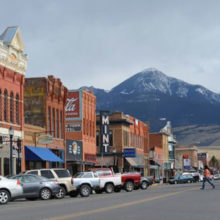Hispanic populations are growing across the West, and the United States hit a tipping point in 2015 in its racial and ethnic make-up: more toddlers under the age of five are now minorities than non-Hispanic whites. Hispanics are the fastest-growing demographic group, and the youngest. Today, one in four kindergarteners nationally is Hispanic.
In the West, Hispanic populations are increasing in many counties. Since 1980, the Hispanic population in the West more than tripled, increasing by 15 million people. Today, Hispanic people account for roughly one in four westerners and one in six rural westerners.
Historically concentrated in the Southwest, the Hispanic population has expanded geographically to nearly all western U.S. counties. While Hispanic numbers have increased the most in the metropolitan West, as a share of total population, dramatic increases also have occurred in rural western counties.
Hispanic Populations and Other Minorities Are Offsetting Decreasing Rural Populations
Many rural western counties are losing population as low natural birth rates combine with high levels of outmigration to metropolitan regions. However, due to growth in minority populations—and especially growth in Hispanic populations—14 percent of rural counties in the West gained instead of lost population, and another 26 percent of counties would have lost population faster.

The top three counties that experienced growth in Hispanics as a share of total population are Clark County in Idaho, Colusa County in California, and Adams County in Washington. These three counties have small populations (fewer than 25,000 residents each) that would be declining if not for increases in Hispanics.
In total, 31 counties (11 percent of the rural West) avoided population decline only because of increases in Hispanics.
Declines in Hispanic Populations Have Been Rare
From 1980 to 2015, only six percent of counties in the entire American West experienced a decline in the share of the people that are Hispanic.
In 18 traditionally Hispanic counties in northern New Mexico and southern Colorado, the Hispanic share of total population has declined in the last 35 years. Most of these counties are traditionally Hispanic and have relatively large Hispanic populations that are increasing in absolute numbers, but not as quickly as non-Hispanic populations. Hence the share of Hispanics has declined.
For example, in Taos, New Mexico, in-migration by non-Hispanic populations is outpacing natural increase in Hispanic residents. In other parts of the region, the trend may be related to general out-migration of young people to metropolitan communities where job prospects are greater–a trend seen in rural counties nationwide.
Hispanics Are Younger and Help Sustain School Districts
America’s Hispanic population is younger as a whole–one third are under age 18–and school districts in communities with Hispanic populations tend to grow faster. Across the nation, Hispanic student enrollment of all ages doubled from 1996 to 2016. Across the West, Hispanics accounted for 86 percent of growth in public school enrollment from 1993 to 2003.
While this growth is most pronounced in places not traditionally Hispanic—including Washington, Oregon, Utah, Nevada and Colorado—in absolute numbers Hispanic enrollment also is increasing in states with historically large Hispanic populations. For many school districts with declining non-Hispanic white populations, a growing Hispanic population can bring in much needed state funding, especially in rural districts that allocate funding based on per-capita enrollment.
Growing school districts also help generate jobs. For example, Adams County, Washington showed the third largest growth in Hispanics as a share of total population in the West. The second-largest employer in the county is the Othello School District, providing more than 500 jobs. Enrollment in Othello public schools is primarily Hispanic. With a declining non-Hispanic white population, growth in Hispanic enrollment helped keep the Othello school district open and related jobs available.
On August 28, 2017, the U.S. Census reported that as Hispanic enrollment in public schools has grown, high school drop-out rates have declined, reaching a low of 9.9 percent in 2016—a drop of nearly 25 points since 1996. Hispanic college enrollment grew by 86 percent in the last decade.
Hispanics in the West & Deferred Action for Childhood Arrivals (DACA)
The Deferred Action for Childhood Arrivals (DACA) program has important implications for many western states.
Six of the eleven western states (California, Arizona, Washington, Colorado, Nevada, and Oregon) are among the top 15 states with Deferred Action for Childhood Arrivals (DACA) recipients, and nationally most DACA recipients are Hispanic—78 percent of applicants are Mexican immigrants.
In Colorado, leaders say the end of the DACA program would have “catastrophic” effects on Denver Public Schools, so important are teachers and students enrolled in DACA. Their deportation would reduce talent in the pool of teachers and cause large declines in enrollment in some districts.
Termination of DACA may also have long-term effects on economies in western communities.
Recent research from the National Academies of Sciences shows that the children of immigrants contribute more in taxes during their working years than other native-born Americans on a per-capita basis. This study finds that immigrants who entered as children have a net-positive effect on tax dollars—an effect that is nearly doubled with a college degree. Sixty-eight percent of DACA recipients over the age of 25 hold or are pursuing a bachelor’s degree.




